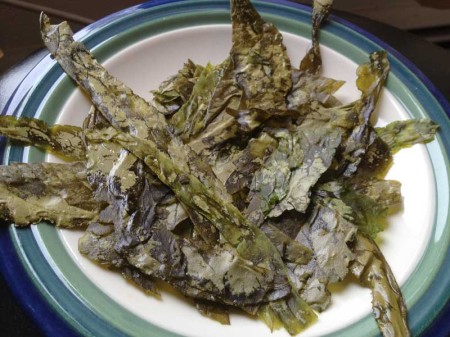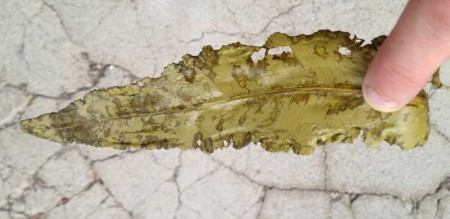
Who needs kale chips when you can have dock chips? For this project—a bastardization of two online recipes for kale chips (Food Network, Allrecipes), I used young curly dock leaves (Rumex crispus) foraged a couple days ago in the outskirts of Fort Collins, Colorado. With the recent rains the dock is looking good, especially if you catch the young, light green leaves shortly after they unfurl, before the bugs have a chance to get to them.
Unlike kale, which is a mustard, dock is in the Polygonaceae family, which includes buckwheat and rhubarb—so the chips are bound to taste different than kale chips to some palates. To my simple one, both give the sensation of a melt-in-your-mouth crisped vegetable, which I find appealing.
One of the kale chips recipes I followed said to cut the leaves from the leaf stems, and to then rip the leaves into pieces. For my first trial I removed them from the midribs but didn’t rip the strips into smaller pieces, which made it easier to flip once they were in the oven. I tossed the leaves in oil and spruce salt and laid them out, not touching each other, on a cookie sheet, baking for probably six minutes at 275 degrees before flipping them over, one by one, using a spatula and my fingers.

The chips came out crispy, slightly translucent, and tasty. I liked them a lot but there wasn’t much to them, such that after we’d eaten our shares I spied my fiancé Gregg reaching for the corn chips. “Hey, haven’t you had enough snacks?” I accused.
Then I tried making a second batch with the midribs intact. I had to cook them longer—10 minutes per side—mind you I’m at 10,000 feet so bake time is longer here than in lower elevations. They were easier to flip and I liked them equally well, if not better, as it made for a more substantial chip. In fact, I found it difficult to stop eating them, which brought to mind a recent comment by a reader that dock is a mild laxative.
In his 2012 textbook, Survival Plants, Cattail Bob Seebeck warns that long term use of Rumex roots can lead to laxative dependence, and that “mature leaves contain toxic amounts of oxalic acid.” Cattail Bob takes a conservative stance that only “very young leaves are edible in small quantities.”
Again, oxalic acid is present in several veggies we eat, like spinach, so my understanding is that it’s something we don’t want to overdo, like by eating an entire pound in one sitting.
That is, in fact, how an ailing individual expired—by eating an estimated 1.1 pounds of dock—Sam Thayer reports in Nature’s Garden (2010) based on Xirgu et al (1989). “Keep your portions within the limits of sanity,” Thayer advises, but young leaves make for good eating.

Some sources warn about the potential of overconsumption to irritate the urinary tract and increase the risk of developing kidney stones.
I also did an online search for “dock chips” just to make sure I wasn’t inadvertently stealing this idea. As it turns out, the Urban Dictionary has an alternate definition for the “dock chip” as “the tastiest, cheesiest, most topping-laden nacho in the pile eaten first by the jerk who did not take the time to make said nachos. Usually more than one chip make up the ‘dock chip’ and is held together by most of the cheese on the plate.”
The good news is that if you make chips out of actual dock, you’ll get to eat the “dock chips” until the plate is clean.
Updated 3.26.21

Here’s my objection to kale chips – they leave my teeth looking like a swamp. How are dock chips in this regard? I think that with their lemon-y flavor, dock chips must be superior to kale in taste.
Ha, I’m notorious for having swamp mouth and not noticing it until Gregg tells me. Standby, I’ll have to make and consume some more dock chips and then look at my mouth. You’ll be the first to know.
Amazing article, Erica!! Kale chips is one of our favourite alternatives to traditional chips
Best wishes
Felix